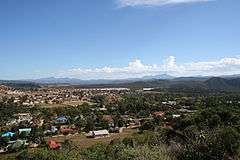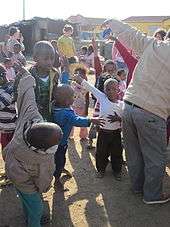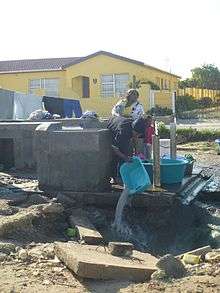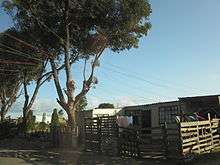Township (South Africa)



In South Africa, the terms township and location usually refer to the often underdeveloped segregated urban areas that, from the late 19th century until the end of apartheid, were reserved for non-whites, namely Indians, Africans and Coloureds. Townships were usually built on the periphery of towns and cities.[1][2] The term township also has a distinct legal meaning in South Africa's system of land title, which carries no racial connotations.
History
During the first half of the twentieth century, a clear majority of black people major urban areas lived in hostels or servants’ accommodations provided by employers and were mostly single men. In the period during and following World War II urban areas of South Africa experienced a rapid period of urbanisation as the colour bar was relaxed due to the war. Neither employers nor the government built new accommodation or homes for the influx of new residents. This led to overcrowding, poor living conditions, and the absence of amenities thereby contributing to high levels of crime and violence. High rents and overcrowding led to land invasions and the growth of shack settlements which were largely ignored by government.[3]
By 1950 a substantial proportion of the urban black population lived in townships. In 1950 upwards of 100,000 people were living in townships on the Witwatersrand, 50,000 people in Cato Manor in Durban, and an estimated 150,000 black and coloured people living in townships in Cape Town.[3]
Living conditions in the shack township settlements were low but had the advantage over other more established options in the hostels of being cheap and largely unregulated by the apartheid era South African Police.[3]
Apartheid
During the apartheid era, black people were evicted from properties that were in areas designated as "white only" and forced to move into segregated townships. Separate townships were established for each of the three designated non-white race groups - black people, Coloureds and Indians) - as per the Population Registration Act, 1950. Legislation that enabled the apartheid government to do this included the Group Areas Act.
Townships for non-whites were also called locations or lokasies in Afrikaans, and are often still referred to by that name in smaller towns. The slang term "kasie", a popular short version of "lokasie" is also used. Townships sometimes have large informal settlements nearby.
Post-apartheid
Most South African towns and cities have at least one township associated with them. Some old townships have seen rapid development since 1994 with, for instance, wealthy and middle-income areas sprouting in parts of Soweto and Chatsworth. Despite their origins in apartheid South Africa, today the terms township, location and informal settlement are not used pejoratively. However policy makers are, as in the 1950s, once again using the term 'slums' in a highly pejorative way.[4]
Social issues
Township communities are faced with several social problems. Most often, the residents of townships do not own the land on which their houses are built. In effect, these houses are built illegally.[5] Construction is informal and unregulated by the government. This results in a lack of access to basic services such as sewage, electricity, roads and clean water, which adversely affects residents' quality of life.[5]
Rehabilitation of infrastructure
There are three infrastructures within the townships that are in need of repair, which are the sewerage, water, and electrical. The problems that each of these infrastructures cause for the residents is mainly due to the lack of sanitation, accessibility, and availability. The government does not help out the people that are not actually residents so they are forced to use the resources of the residents, which end up causing more problems for the whole community. Matters are made worse because each of these infrastructures are serviced by different department so the efficiency goes down unless there is substantial co-ordination at all stages of the project planning, budgeting, and implementation cycle.[5]
Sewerage
The sewerage system within the townships is very poorly planned and constructed. The population of the townships typically grows faster that the infrastructure was planned for, causing an overload on the system. The overload then causes problems such as frequent blockages or surges, as well as spilling over and causing the roads to flood. Most areas within the townships have a limited number of public toilets that are over used, abused, and quickly become health hazards for the community. One problem that was not foreseen when building the houses so close together and so densely packed in one area, is the poor access for maintenance of the sewerage system. The limited space between houses makes access for pipe maintenance challenging, and can could potentially end up causing more issues such as more flooding, traffic around the area of construction, and a long wait for the resident to go without water. Some of the areas on the township peripheries or near riverbanks do not have access to facilities because they are not connected to the formal waterborne sewerage system.
Water
The water is a very challenging situation to deal with. With the mass numbers of residents the pressure of the pumps become very low because the way it is being used so much at the same time. With low pressure the water becomes difficult to get and sparse amounts are already available to each household. With each section of the townships is normally one pump per section. The water is used for everything from cleaning clothes, cooking, drinking, bathing, and cleaning the house. Having very little water accessible to each section makes it very hard to get enough water for a day per household.[5] One way that this could be ameliorated is to make some improvements to the main water supply and to add more pumps in each region in the township but have it coming from a different water system allowing more water in each area but without dealing with lower pressure.

Electricity
The overloading of electrical wires strung along the trees leading to the only power box in the area is an ubiquitous sight in the townships. Hundreds of wires come off of the power box because the residents of the area were not given access to the electricity they need so they decided they would take it. This is of course illegal and not to mention very dangerous but every house in the area has a wire coming out of it and every wire is known by their owner in order to fix problems as soon as they arise.[6] Most of the sub-stations are very unsecured to begin with so having so many additional wires coming off of it is very dangerous for the people nearby and the kids playing in the area. The government does not like that the people using the sub-stations are not actual residents so they refuse to give them electricity but if they were to install more sub-stations then the problem would be solved.[5]

Tributaries and river banks
Some of the townships, such as Alexandra and Diepsloot, are built along or by a tributary or river bank. This causes problems with the high density of people, poor access, and services. These areas are extremely dense with only tortuous, narrow access, few communal water points and banks of chemical toilets on the peripheries of the settlements. The settlements are beginning to be built in the old tributaries due to the continuing growth of the townships. With the houses in the dried up tributaries is a potential problem when a large storm comes and the tributary starts to fill up with water again or if there is a backup of sewerage coming into the tributary. The houses built in that area are all in danger of being destroyed by natural occurrences. As the area grew the tributaries were piped and a number of concrete aprons and gullies were constructed over the tributary to which the communal water points drain. The gullies were then choked with garbage and the tributaries appear to be substantially blocked but this will not hold off the water for very long if a flood came through.[5] Flooding is also an issue in the river bank areas where houses were built. These houses should be relocated but most places are running out of space to expand which is how those houses ended up in the area below the flood lines. Some people think it could be a good thing to live next to s river in order to be able to use the water to do laundry and clean but most of the time the water in that area is so polluted and trashed that it is unsanitary for them to use due to all the local pollutant of nearby factories or plants.
Backyard shacks
Backyard shacks are additional units on a plot of land that are rented out by the land owner as a significant income to the main householder. A plot of land designed for a house big enough for one family has turned into a plot of land that holds on average six families instead of one.[5] These structures are indeed illegal by the government and built without compliance with planning and building code norms and have made servicing and maintenance very difficult for the whole community. Having an excessive number of people on one plot of land has created inevitable strains on the infrastructure and services causing capacity and blockage problems. The government refuses to make the backyard shacks legal but it would unethical to make that large a number of people move so a compromise is needed in order to satisfy both parties. In the township called Diepsloot near Johannesburg a study was done in 2001 and it shows that 24% of the residents lived in brick structures, 43% were in shack areas, and 27% were in backyard shacks.[6]
Education
_09.jpg)
Changes have been attempted within the last few years to make the education system better but one of the biggest problems facing South African youths is the lack of education.[7] The education system in South Africa is set up differently from the rest of the world. School life spans 13 years or grades, from grade 0, other wise known as grade R or "reception year", through to grade 12 or "matric". All South Africans have the right to a basic education but most of the kids in the poor areas end up dropping out around 9th grade.[8] The Bill of Rights of the country's Constitution states that they have the obligation, through reasonable measures, to progressively make education available and accessible. Then in the South African Schools Act of 1996 education became compulsory for all South Africans from the age of seven to age 15, or the completion of 9th grade.[8] In order to target the education of the poorest of the poor the government created two notable programs. One is the fee-free schools, institutions that receive all their required funding from the state and so do not have to charge school fees. These schools were carefully identified in the country's most poverty-stricken areas, and will made up 40% of all school in 2007.[8] The other is the National Schools Nutrition Program, which feeds about 7 million schoolchildren every day. The government is targeting improvements in the infrastructure for poorer school including libraries, laboratory, and sports fields as well as improvements in math and science scores. Other strategies include learner transport, crime campaigns to address violence, sexual abuse and gangsterism, the "Drop-all-and-read" campaign that focuses on basic literacy and numeracy skills.[9] After the implementation of these programs the national budget has increased as well as the matric pass rate and total number of students.[8] Even with all these increases and positive transformations they have not been accompanied by a better distribution of education. This skewed distribution is mainly attributable to higher and more rapid drop out rates among the poor, rather than to a lack of initial access to schooling.[9] The formerly white Model-C schools uniformly produce better results and their governing bodies are able to raise substantial private funds used to get resources that are then unreachable by the rural and township schools which survive on the commitment of their teachers.[9]
Gangs and violence
Children as young as 12 or 13 will begin the initiation into a local gang. Children that begin that young have a role model that is a gang, which is the reason for their own induction. Some see violence and gangs as a way of life and a culture. So if their role model is seen doing something wrong they do not see it as a crime but idolized. Without a conviction of the wrongdoers the children's sense of morality becomes distorted. Some blame the apartheid for leaving a bitter legacy of poverty, inequality, and the nobility of violence. The weapon of choice for most is a gun and with easy accessibility anyone is able to get one. It is estimated that out of the 14 million guns in circulation, in South Africa, only four million are registered and licensed to legal gun owners.[10]
Largest townships
Largest townships in South Africa at the time of the 2011 census:
| Township | Population | Neighbouring city/town |
|---|---|---|
| Soweto | 1,271,628 | Johannesburg |
| Tembisa | 463,109 | Kempton Park |
| Katlehong | 407,294 | Germiston |
| Umlazi | 404,811 | Durban |
| Soshanguve | 403,162 | Pretoria |
| Khayelitsha | 391,749 | Cape Town |
| Mamelodi | 334,577 | Pretoria |
| Mitchell's Plain | 310,485 | Cape Town |
| Daveyton / Etwatwa | 279,033 | Benoni |
| Ibhayi | 237,799 | Port Elizabeth |
| Sebokeng | 218,515 | Vanderbijlpark |
| Mangaung | 217,076 | Bloemfontein |
| Ivory Park | 184,383 | Midrand |
| Botshabelo | 181,712 | Bloemfontein |
| Alexandra | 179,624 | Johannesburg |
| Kwa-Mashu | 175,663 | Durban |
| Vosloorus | 163,216 | Boksburg |
| Mdantsane | 156,835 | East London |
| Meadowlands | 138,354 | Roodepoort |
| Tsakane | 135,994 | Brakpan |
| Thabong | 135,613 | Welkom |
| Evaton | 132,851 | Vanderbijlpark |
| Township | Population | Neighbouring city/town |
|---|---|---|
| Ntuzuma | 125,394 | |
| Madadeni | 119,497 | Newcastle |
| Embalenhle | 118,889 | Secunda |
| Kagiso | 115,802 | Krugersdorp |
| Mabopane | 110,972 | Pretoria |
| KwaNobuhle | 107,407 | Uitenhage |
| Saulsville | 105,208 | Pretoria |
| Jouberton | 104,977 | Klerksdorp |
| Thokoza | 105,827 | Alberton |
| KwaThema | 99,517 | Springs, Gauteng |
| Guguletu | 98,468 | Cape Town |
| Diepsloot | 95,067 | Johannesburg |
| Ga-Rankuwa | 90,945 | Pretoria |
| Seshego | 83,863 | Polokwane |
| Edendale | 79,573 | Pietermaritzburg |
| Osizweni | 77,845 | Newcastle |
| Orange Farm | 76,767 | Johannesburg |
| Hlubi | 73,931 | Newcastle |
| Duduza | 73,295 | Nigel, Gauteng |
| Mpumalanga | 62,406 | Pinetown |
| Matsulu | 47,306 | Nelspruit |
| Mahwelereng | 41,072 | Mokopane |
| Sharpeville | 37,599 | Vereeniging |
| Namakgale | 36,365 | Phalaborwa |
| Ipelegeng | 35,495 | Schweizer-Reneke |
| Mankweng | 33,783 | Polokwane |
| Imbali | 30,157 | Pietermaritzburg |
 Construction of a house in the former township Dukathole (near Aliwal North)
Construction of a house in the former township Dukathole (near Aliwal North) A bigger shack made of corrugated iron within Dukathole
A bigger shack made of corrugated iron within Dukathole Little shop on the main street of Dukathole
Little shop on the main street of Dukathole Dukathole - Street scene
Dukathole - Street scene
Legal meaning
The legal meaning of the term "township" in South Africa differs from the popular usage, and has a precise legal meaning[11][12] without any racial connotations. The term is used in land titles and townships are subdivided into erfs (stands).[13] "Township" can also mean a designated area or district. For instance "Industrial Township" has been used in reference to an industrial area, e.g. "Westmead Industrial Township", in Pinetown, South Africa.
Often a township (in the legal sense) is established, and then adjoining townships, with the same name as the original township, and with a numbered "Extension" suffix are later established. For example, the Johannesburg suburb of Bryanston has an extension called Bryanston Extension 3 .
Relationship with "suburb"
In traditionally or historically white areas, the term "suburb" is used for legally-defined residential townships in everyday conversation.
A suburb's boundaries are often regarded as being the same as the (legal) township boundaries, along with its numbered extensions, and it usually shares its name with the township (with some notable exceptions, such as the Johannesburg suburb known as Rivonia, which is actually the township of Edenburg with numbered extensions called Rivonia Extensions).
Occasionally formerly independent towns, such as Sandton (which itself consists of numerous suburbs), are referred to as "suburbs" .
See also
- HIV/AIDS in South African townships
- Bantustan
- Ghetto
- Racial segregation
- Township tourism
- Old Location, a township of Windhoek, Namibia
References
- ↑ Pettman, Charles (1913). Africanderisms; a glossary of South African colloquial words and phrases and of place and other names. Longmans, Green and Co. p. 298.
- ↑ International Encyclopedia of the Social Sciences (PDF). p. 406.
- 1 2 3 Seekings, Jeremy; Nattrass, Nicoli (2005). "Class, Race, and Inequality in South Africa" (PDF). sahistory.org.za. Yale University Press. p. 63. Retrieved 23 May 2017.
- ↑ Huchzermeyer, M., (2011).Cities with ‘Slums’: From Informal Settlement Eradication to a Right To The City In Africa University of Cape Town Press, Cape Town
- 1 2 3 4 5 6 7 Interactive Planning Workshop for Johannesburg. Greater Johannesburg Metropolitan Council. Johannesburg, South Africa. 27–30 September 2000. Web. 8 October 2011. <http://web.mit.edu/urbanupgrading/upgrading/case-examples/overview-africa/alexandra-township.html>
- 1 2 Harber, Anton. Diepsloot. Jeppestown: Jonathan Ball Publishers LTD, 2011. 2011. 1-226. Print.
- ↑ Mvunganyl, Jackson. "US NGO Teams with South African Schools to Enhance Education in Townships." Voice of America. (2011): n. page. Web. 8 October 2011. <http://www.voanews.com/english/news/africa/US-NGO-Teams-with-South-African-Schools-to-Enhance-Education-in-Townships020411-115306769.html>
- 1 2 3 4 "Education in South Africa". SouthAfrica.info. N.p., n.d. Web. 8 October 2011.
- 1 2 3 Motloung, Hloni. "Township and Rural Schools continue to be marginalized as inequality in the education system persists commented Graeme Bloch, Education Specialist, Development Bank of Southern Africa at the Knowledge Week." n.d. n. page. Print.
- ↑ "Guns, gangs and culture of violence." BBC News. (2002): n. page. Web. 19 October 2011. <http://news.bbc.co.uk/2/hi/africa/1919382.stm>
- ↑ http://www.lawsoc.co.za/webs/surveyorgeneral/survey_system_sa/survey_system_sa.doc
- ↑ http://www.info.gov.za/view/DownloadFileAction?id=70824
- ↑ http://www.lts.co.za/projectcycle.html
External links
| Wikimedia Commons has media related to Slums in South Africa. |